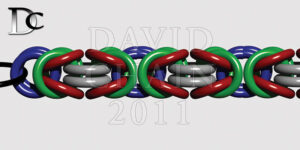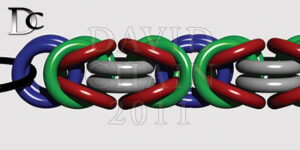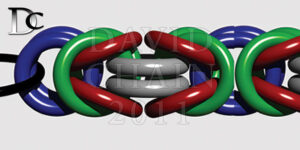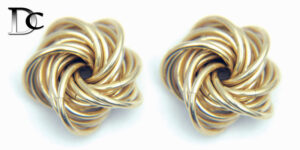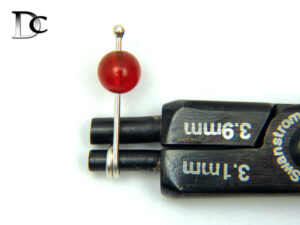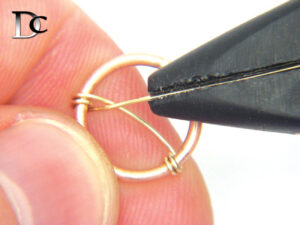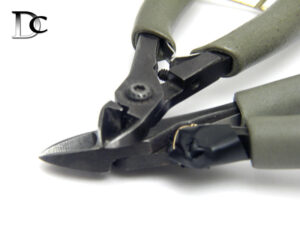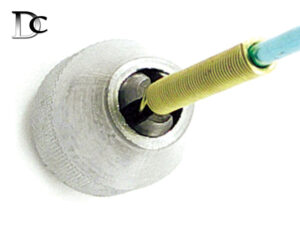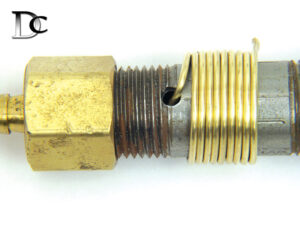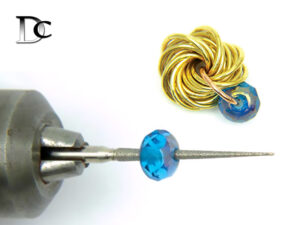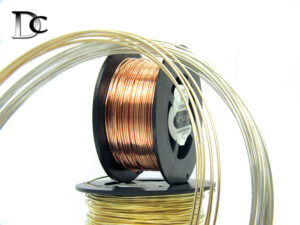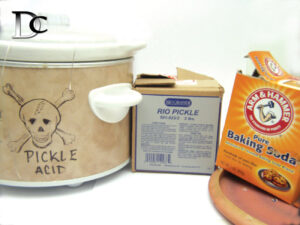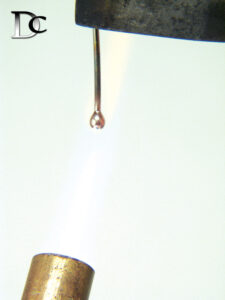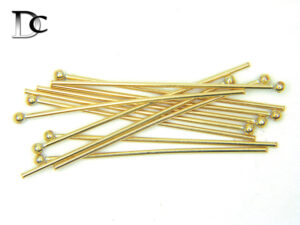Books and tutorials can inspire your jewelry adventure, but your success will be limited by using the correctly-sized jump rings, and your enjoyment of the chain-making process will be enhanced by using proper hand tools. To guide your successful journey, this page illustrates the jump ring sizes, hand tools, and studio supplies that I utilize. Hidden within this page, like Easter egg candies, are PDF tutorials about the fundamental skills needed for handcrafting beaded chain jewelry, from ring closure and bead setting, to S-clasp forging and making custom headpins.
20-gauge (0.812mm) with 2.75mm ID ring
♦ Jump ring size 7:20 at Spiderchain
This jump ring size creates a fine Byzantine chain, making 5½ knot formations per inch of chain, and is combined with the 16-gauge, 4.5mm ID connector rings for more advanced designs.
♥ I only recommended this ring size for advanced weavers, as they are very tiny and delicate!
19-gauge (0.914mm) with 3.1mm ID ring
♦ Jump ring size 3.1m19 at Spiderchain
This jump ring size creates a small Byzantine chain, making 5 knot formations per inch of chain, and is combined with the 15-gauge, 5mm ID connector rings for more advanced designs.
♥ I love this ring size for making geometric patterns, as 20g is too weak and 18g too heavy.
18-gauge (1.02mm) with 3.5mm ID ring
♦ Jump ring size 3.5m18 at Spiderchain
This jump ring size creates a normal Byzantine chain, making 4 knot formations per inch of chain, and is combined with the 14-gauge, 5.5mm ID connector rings for more advanced designs. ♥ I recommend this ring size for beginners learning how to make the Byzantine chain.
16-gauge (1.3mm) with 4.1mm ID ring
♦ Jump ring size 10:16 at Spiderchain
This jump ring size is adaptable to create three different chain patterns: 1) the Jens Pind chain (as shown), 2) the Double chain (assembled 2+2+2), or 3) the Single chain (assembled 1+1+1) with enough space between the rings to add dangling charms.
18-gauge (1.02mm) with 4.5mm ID ring
♦ Jump ring size 4.5m18 at Spiderchain
This jump ring size is adaptable to create four different chain patterns: 1) the Inca Puño chain (as shown), 2) the spiraling Flower chain, 3) the repetitive Mobius chain, or 4) the alternating Dubious chain. ♥ All four of these unique chain patterns are illustrated in the 2nd Book.
16-gauge (1.3mm) with 4.5mm ID ring
♦ Jump ring size 11:16 at Spiderchain
This jump ring size creates a large Byzantine chain, making 3½ knot formations per inch of chain, and also serves as the connector rings in combination with the tiny 20-gauge, 2.75mm ID rings to make advanced geometric and organic designs.
15-gauge (1.45mm) with 5mm ID ring
♦ Jump ring size 13:15 at Spiderchain
This jump ring size creates a masculine Byzantine chain, making 3 knot formations per inch of chain, and also serves as the larger connector rings in combination with the smaller 19-gauge, 3.1mm ID rings to make geometric designs.
14-gauge (1.63mm) with 5.5mm ID ring
♦ Jump ring size 14:14 at Spiderchain
This jump ring size creates a massive Byzantine chain, making 2½ knot formations per inch of chain, and also serves as the larger connector rings in combination with the smaller 18-gauge, 3.5mm ID rings, as well as the S-clasp catch rings.
17-gauge (1.14mm) with 8.75mm ID ring
♦ Jump ring size 22:17 at Spiderchain
This large-diameter jump ring size is utilized throughout the 4th book’s Spiral chapter, from the 2-ring Flower Petal designs, and 3-ring Large Flower designs, to the 5-ring Mobius designs, and the 20-ring Spiral Ball designs (as shown).
Proper Hand Tools
Flat-nose Pliers
♦ Available exclusively at Rio Grande
Swanstrom short-jaw flat-nose pliers are used in tandem, one in each hand, for opening and closing jump rings. The shortened jaw length is ideal for working with delicate jump rings, and you get much closer to the chain as its being weaved. Learn how to properly close each ring.
Chain-nose Pliers
♦ Available exclusively at Rio Grande
Swanstrom micro-sized chain-nose pliers are required for closing that last pesky ring in tight geometric chain patterns. The pointed tips also makes them ideal for smashing crimp tubes to secure beading cable, and working with delicate 24-gauge wire, as shown.
Round-nose Pliers
♦ Available exclusively at Rio Grande
Swanstrom micro-sized round-nose pliers are used for bending round loops from straight wire.
♥ Notice that I made two small grooves on the jaws at 2.75mm and 3.1mm diameter. The smaller 2.75mm diameter is used for bending the small loop of the Custom Earring Backs.
Mandrel-tip Pliers (3.1 + 3.9mm)
♦ Available exclusively at Spiderchain
Swanstrom mandrel-tip pliers have a 3.1mm jaw and a 3.9mm jaw, designed for setting beads onto headpins with a specific diameter loop, which can then be assembled into a chain to create a seamless beaded chain pattern.
♥ The 3.1mm is ideal for setting beads into the 19-gauge Byzantine chain, and the 3.9mm is used for setting beads into the 19-gauge Inca Puño chain and the 3-ring Large Flower design.
Mandrel-tip Pliers (3.5 + 4.5mm)
♦ Available exclusively at Spiderchain
Swanstrom mandrel-tip pliers have a 3.5mm jaw and a 4.5mm jaw, designed for setting beads onto headpins with a specific diameter loop, which can then be assembled into a chain to create a seamless beaded chain pattern.
♥ The 3.5mm is ideal for setting beads into the 18-gauge Byzantine chain, and the 3.9mm is used for setting beads into the 18-gauge Inca Puño chain.
Nylon-tip Pliers
♦ Available exclusively at Rio Grande
Swanstrom nylon-tip (delrin) pliers are used to straighten fine 24-gauge wire to allow the addition of gemstone beads between wire wrappings, as shown.
♥ Practice your bead-setting skills onto fine 24-gauge to create the Figure Eight design from the 5th book.
Side-cutters
♦ Available exclusively at Rio Grande (small)
♦ Available exclusively at Rio Grande (large)
Swanstrom ‘super-flush’ side-cutters are used for trimming beading cable and cutting coils into jump rings. The smaller size (top) is designed to cut fine wire up to 18-gauge thickness, and the larger size (bottom) is designed for cutting thicker wire up to 14-gauge thickness.
♥ I secured the set-screw with black plastic ‘electricians’ tape and fine wire, as you want to prevent the blades from touching when you cut wire or they will quickly get dull.
Jewelry Files
♦ Available exclusively at Rio Grande (round)
♦ Available exclusively at Rio Grande (flat)
The round ‘rat-tail’ file (top) is used for removing any metal burr from the inside, and the flat ‘equaling’ file (middle) is used for removing any metal burr from the outside of a closed ring.
♥ I added colored tape (bottom) onto the handle to make them easier to find on my work bench.
Sanding Pads
♦ Available at Rio Grande
Superfine (320-grit) 3M sanding pads with foam backing are perfect for smoothing the joint of each closed ring after using a file to remove the burr; the scuffing from the 320-grit sanding will polish out in the steel-shot tumbling to create visually seamless rings.
♥ You can easily cut the large pad into smaller 1″ sections with common scissors.
A pencil-point compass (top) is used to find the 3 points of a triangle on a Solderite board for the 3-ring Propeller design in the 5th book, and can be found at book shops or art supply stores.
A digital caliper (middle) is essential to measure the thickness of wire, inside diameter of jump rings, and the outside diameter of a knitting needle mandrels. ♦ Available at Rio Grande
A fabric measuring tape (bottom) is used to measure lengths of wire and can be cut to length. This also serves to measure your client’s wrist or neckline, and easily sourced at any craft store.
Hammer and Anvil
♦ Hammer at Rio Grande
♦ Anvil at Rio Grande
A Fretz 3.1oz Planishing hammer and 80mm² bench-block anvil are used in tandem to flatten, shape, and forge 14-gauge round metal wire into the signature S-clasp design and more.
Electric Screwdriver
This 3.6-volt electric screwdriver has a hex-base that accepts a three-prong Jacobs chuck adapter, as shown. You should be able to find this low-speed tool at your local hardware store.
♥ I do not recommend using an ‘electric drill’, which turn much faster and could be dangerous.
Jacobs Chuck
♦ Available at WireSculpture
This 3-prong Jacobs chuck has a hex-base that fits into the 3.6-volt electric screwdriver. The three-prongs are easily adjusted by hand to hold a variety of mandrels for wrapping wire into a coil, which would then be cut into many individual jump rings.
♥ Notice that the end of the wire is placed between two of the three prongs of the chuck, which is necessary to hold the coil’s tension for the wire-wrapping process.
Knitting Needle Mandrels
Aluminum knitting needles are ideal for wire-wrapping mandrels, as they are a consistent diameter along their length, and easily sourced at your local craft store (or ask your mom – grin).
♥ You will need to use your digital calipers to measure their actual diameter, as they can be slightly smaller or larger than the packaging label size, and do not use bamboo knitting needles.
Gas Pipe Mandrels
To create large-diameter (11mm, 13.5mm, and 23mm) rings for the projects in the 5th book, I use a variety of steel gas pipe sections that can be easily sourced at your local hardware store. Each pipe is fitted with a decreasing coupler tube fitting, which allows the pipe to be held in the three-prong chuck set into the 3.6-volt electric screwdriver for wrapping wire into a coil.
♥ Before you can wrap wire, you will need to drill a hole into the pipe at the end of the threads, allowing the wire to hook into the pipe and hold the coil’s tension for the wire-wrapping process.
Bead Reamer Tip
♦ Available at Rio Grande
This Bead Reamer Tip is used to enlarge the hole within a bead to allow the curvature of a large-diameter (8.75mm) ring to pass through for embellishing the Spiral Ball design in the 4th book.
♥ I recommend that you perform this bead-reaming operation slowly; working on both sides of the bead within a bowl of water to help keep the bead cool, or it might crack from friction heat.
Studio Supplies
Frisbee Golf Discs
These 8-inch diameter discs hold all the findings and pliers for assembling a specific project, and each disc can hold six aluminum triangular pans to organized multiple bead sizes.
♥ When I was backpacking around the world, my mobile chain-making craft was safely transported between two discs that were duct-taped together around the edges.
Round Metal Wire
Metal wire is available in a variety of shapes (cross-section), thicknesses (gauge), hardness (tempering), and metal alloys (mixing of metals), which can be overwhelming to understand, so let me try to simplify. I have always used round wire. I always used AWG (American Wire Gauge) wire in a variety of thicknesses from thin 24-gauge (0.51mm) to thick 10-gauge (2.59mm). I recommend getting ‘half-hard’ tempering for most wire gauges; however for thick wire (12g and 10g) I get ‘dead soft’, as they quickly work-harden. I have used a variety of metal alloys: 18K yellow gold (75% gold + 12.5% silver + 12.5% copper), sterling silver (92.5% silver + 7.5% copper), Argentium silver (92.5% silver + 6.3% copper + 1.2% germanium), red brass ‘AKA jewelry bronze’ (85% copper + 15% zinc), yellow brass (67% copper + 33% zinc) and copper wire. ♦ Rio Grande
Beading Wire and Crimp Tubes
♦ Available at Rio Grande (cable)
♦ Available at Rio Grande (tubes)
I use 19-strand stainless steel-braided, nylon-coated Beadalon brand beading wire for setting beads into chain patterns, which is then secured with a smashed sterling silver crimp tube.
♥ For precision and security, the beading wire is 0.30mm (.012″) thick and the crimp tube has a 0.75mm (.03″) ID, which allows two cables to pass through the tube in an overlapping pattern.
Argentium Solder Paste
♦ Available at Rio Grande (paste)
♦ Available at Rio Grande (syringe)
♦ Available at Rio Grande (tip)
Argentium silver solder paste is sold as half ounce quantity exclusively by Rio Grande (top). I transfer a small amount of paste into a smaller 3cc syringe (middle), and use an 18-gauge pink tip that receives a 19-gauge pin (bottom) to help keep the paste from drying out too fast.
Blazer Butane Torch
♦ Available at Rio Grande
I highly recommend the Blazer brand butane torch for consistent silver soldering of your jewelry designs. For your safety, I do not recommend the cheaper butane torches that are available for ‘creme brulee’ kitchen use, as they can get dangerously overheated with extended use.
♥ The butane fuel refill bottles cannot be mailed, but you can find them at your hardware store.
Solderite Board
♦ Available at Rio Grande
The 6-inch x 6-inch Solderite board is ideal for soldering your jewelry designs with a butane torch, as it reflects the heat to the metal, cools quickly, and will not burn your tabletop surface.
♥ Discover more details about this simplified soldering technique in the 4th book and 5th book.
Pickle Cleaning Solution
♦ Available at Rio Grande
The Rio Pickle acid powder (middle) is mixed with water and warmed in a crock-pot (left) and used to remove any oxidation patina or heat discoloration from the metal’s surface after soldering. Never let the pickle solution get so hot that it boils, and always neutralize the pickled metal with baking soda (right) and then rinse with water before handling.
♥ label the crock-pot with a skull and crossbones, as shown, so it is never used for food.
Rotary Tumbler
♦ Available at Rio Grande (tumbler)
♦ Available at Rio Grande (shot)
Lortone brand rotary tumblers are excellent for polishing your finished jewelry designs with stainless steel shot and water to strengthen the metal and provide a bling-bling shine.
♥ I use a drop of Dawn brand dish soap just to add some lubrication to the tumbling process.
Propane Torch for Teardropping Technique
A common propane torch, available at any hardware store, provides a very hot flame. Note that I do not use this torch for soldering when I need to bring the flame to the metal. Inversely, I use this torch when I need to bring the metal to the flame, especially for the ‘teardropping’ technique to ball-up the tip of 19-gauge Argentium silver wire to make my own headpin wires to create custom earring backs and beautiful bead settings. I also use this torch to ‘teardrop’ larger 16-gauge Argentium wire for designs in the 4th book.
Pre-made 19-gauge Headpins
If you choose not to use a propane torch, you can purchase pre-made 19-gauge headpins that terminate with a 2mm ball in 1.5-inch (bead setting) and 2-inch (earring backs) lengths.
♦ 1.5-inch sterling silver at metalclayfindings
♦ 2-inch sterling silver at metalclayfindings
Metal Clay Findings makes a variety of top quality jewelry findings for professional jewelers, from tubes and headpins to beads and cufflinks. At the moment, they are no longer selling these headpins in 14-karat gold as shown, but they are selling these headpins in sterling silver.
♥ I use the 19-gauge, 1.5-inch length headpins for setting gemstone beads into chain designs.
♥ I use the 19-gauge, 2-inch length headpins for Custom Earring Backs and Tornado Earrings.



